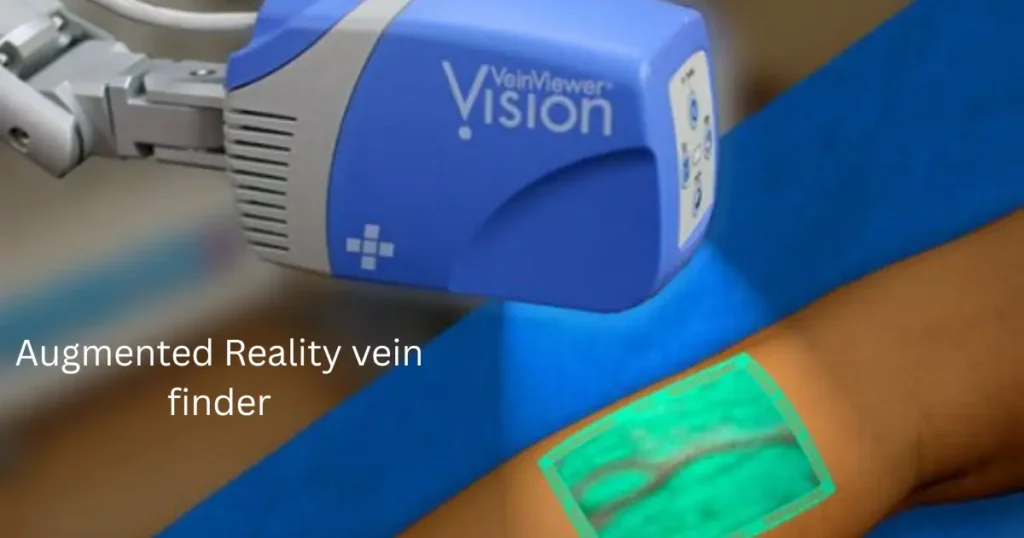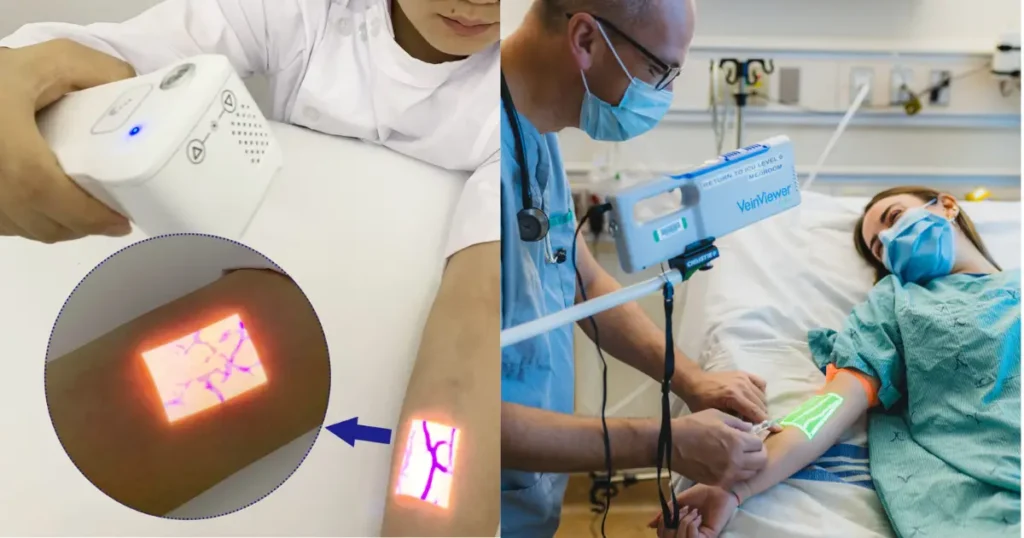
Augmented reality vein finder technology has brought a fresh change to how veins are seen during medical procedures. It uses advanced tools to show vein patterns clearly, even before a needle touches the skin. Augmented reality in healthcare is growing quickly in the U.S., and vein visualization is one of its most exciting uses.
An augmented reality vein finder is a medical-imaging device that uses optical and infrared technologies to visualize subcutaneous veins and superimpose the vein information onto the patient’s skin surface. In effect, it lets a clinician “see through” the skin (to a limited depth) to locate veins for procedures such as IV insertion or blood draws.
Where it differs from simple optical visualization is the overlay or projection of the vein pattern in real time onto the skin (or via a screen) so that the clinician doesn’t just infer the vein’s position but can follow a mapped path. Some manufacturers call it a “vein viewer,” “vein mapper,” or “projection vein finder.”
Clinics and hospitals can use AR to avoid mistakes and reduce patient discomfort. AR projects real-time vein images directly on the skin, helping medical staff find even the hardest-to-locate veins. AR vein visualization helps save time, reduce errors, and make patients feel safer.
Evolution of AR Vein Finders in Healthcare
It’s easy to assume that AR in medicine is new, but the journey began over two decades ago.
The early 2000s saw a wave of NIR-based imaging patents, many inspired by Zeman’s prototype, leading to commercial launches like VeinViewer Classic and AccuVein AV400.
Today’s devices feature AI-enhanced segmentation, 3D contour compensation, and even AR-glass integration. They’re smaller, faster, and more affordable than ever before.
Hospitals and clinics now use AR vein finders not just for routine blood draws but also for oncology, pediatrics, geriatrics, and emergency medicine, where seconds can save lives.
History of Vein Finder
In the mid-1990s, early innovators laid the groundwork for today’s projection-based systems. Over the 2000s, clinical prototypes evolved into hospital-grade products like VeinViewer and AccuVein, and the tech kept shrinking, speeding up, and getting smarter. Below is a tight timeline that traces how NIR + projection matured into the tools clinicians use today.
• 1995–2000: The breakthrough idea. Physicist Herbert Zeman pioneers near-infrared vein imaging, which captures NIR contrast from deoxygenated hemoglobin, processes it, and projects the vein map back onto the skin. Concepts from this era directly seed today’s systems.
• 2006: First clinical reports with projection back onto skin. Miyake, Zeman, and colleagues published on a device that captures NIR, processes the image, and projects a green vein map, an early public clinical test of what we now call AR vein visualization.
• Late 2000s–2010s: Commercialization. VeinViewer models popularize the “capture-process-project” loop; AccuVein offers a Class 1 laser handheld that’s permanently aligned and doesn’t require calibration, projecting veins up to ~10 mm in depth.
• 2020s–today: Refinement and breadth. Systems add HD projection, valve/bifurcation visualization, and training/skills portals; newer workflows demonstrate value in EDs, oncology, pediatrics, and aesthetics, and hybrid approaches pair NIR with ultrasound for difficult-access procedures.
Bottom line: The augmented reality vein finder is not a gimmick, it’s the product of decades of optical engineering and clinical iteration
Benefits of Using Vein Finders for Clinicians and Patients
There are many reasons that clinics utilize an AR vein locator. For healthcare employees, these tools help to reduce the number of failed attempts to find veins and help speed up the process. For patients, they ease anxiety and pain, particularly for those who have a fear of needles or veins that are difficult to locate.
With AR, the doctors and nurses do not have to guess anymore. They can pinpoint exactly where the vein lies. It increases the effectiveness of phlebotomy and provides patients with a more pleasant experience. In several clinics, utilizing AR tools can also help improve the patients’ satisfaction scores.
Clinical Accuracy and First-Stick Success Rates
Many studies in clinical research show that vein finders powered by AR enhance precision. One of the most important results is improving the first-stick success rate. It means fewer needles are inserted, less pain, and speedier procedures.
A study that utilized a VAT score demonstrated that when an eight or more, the success rate was nearly 90 95%. If AR was employed and patients scored higher, they were more likely to be accepted for blood donation. It decreases the rate of re-puncture and misses goals.
Augmented Reality vs Ultrasound for Vein Detection

Ultrasound has been around for longer and is ideal for locating deep veins. It’s utilized for putting in PICC veins and detecting blood clots. However, ultrasound machines are costly and require specific instruction.
Comparatively, the augmented reality vein finder is tiny, handheld, and simple. They’re ideal for the superficial vein access, such as drawing blood or administering IVs. They’re also cheaper and convenient than an ultrasound.
Applications of Augmented Reality Vein Finders
Clinical & Emergency Settings
Hospitals deploy AR vein finders in ICUs, ERs, and oncology units for everything from blood draws to IV cannulation.
They’re especially valuable for dehydrated, elderly, or pediatric patients, where veins are either invisible or collapse easily.
Cosmetic & Aesthetic Procedures
In aesthetic medicine, AR devices prevent accidental intravascular injection during filler procedures or sclerotherapy.
Brands like VeinViewer are even used in cosmetic clinics across Europe and the UAE.
Home Healthcare & Self-Administered Use
Patients managing conditions like diabetes or fertility treatments can benefit from handheld Augmented Reality vein finder under clinical supervision.
Medical Training
Nursing schools and simulation centers use AR vein finders to teach safe, accurate venipuncture techniques without risking real patients.
Infrared Technology: Modern Vein Finders
Infrared technology is a modern way of vein finding. It’s a part of the electromagnetic spectrum, including the visible and microwave Spectrum. Haemoglobin absorbs near-infrared radiation, which makes veins appear darker and easier to spot.
Contrary to far-infrared, which produces heat, near-infrared can be considered safe. It’s also used for cosmetics, red light therapy, and skin rejuvenation. However, in vein finders, it assists medical staff to perform their work more efficiently and effectively.
Top Devices of Augmented Reality vein Finder

The U.S. market has many AR vein locators. The most reputable brands include AccuVein, NextVein, and Infinium. These brands provide FDA-approved portable and simple-to-use tools for clinics and hospitals.
This table is a quick and easy way to compare the best models:
| Device | Key Feature | Price Range | Best Use |
| AccuVein AV500 | Handheld, color modes, | $4,000 | ER, Pediatrics |
| NextVein V800NV | Projection of green/white | $2,000-$3,000 | Outpatient clinics |
| Infinium VS500 | Adjustable brightness | $3,500 | General use |
Advantages of Augmented Reality Vein Finders
Hospital administrators are often concerned about the cost, but data tells a different story. A cost of $4,000 for a device used to treat between 2,000 and 1,500 patients per year for five years will cost less than $1 per session. It’s less expensive than gloves and syringes.
These tools can also reduce waste of materials, escalations, and nurses’ workload. In emergency departments and the blood bank, each second is vital. The use of VR vein visualization tools enhances speed and quality.
Challenges to Adoption in Hospitals and Clinics

With all the advantages, there are still clinics that hesitate. A significant issue is the comfort of the public. Certain people are not a fan of the idea that machines perform jobs requiring human effort. They also fear being deprived of the “human touch.”
Another concern is the initial cost and education. Rural or smaller clinics might not have the money. The staff must also be taught to utilize these tools correctly, which requires patience and planning.
Types of Augmented Reality Vein Finder Devices
Let’s break down the major categories so you can understand which fits each medical context.
1. Handheld Projection-Based Units
These are portable, lightweight devices that project a green or red vein map directly on the skin.
Common examples include AccuVein AV500 and Hellovein Lite 2.0.
Perfect for clinics, mobile phlebotomy, and home healthcare settings.
2. Cart-Mounted or Fixed Systems
High-end hospitals often use VeinViewer Vision2 or NextVein System, mounted on adjustable arms for continuous operation during surgery or IV therapy.
3. Smartphone-Based AR Apps
Want to try the tech on a budget? Apps like VeinSeek Pro and VeinScanner Pro use your phone’s camera and simulated infrared filters to locate superficial veins.
They’re not clinical-grade, but great for training and demonstration purposes.
4. Hybrid Camera + Projector Systems
The NextVein combines camera capture and projected overlay, correcting parallax errors and offering high-accuracy alignment.
These systems are often used in emergency departments and intensive-care units.
Future of Vein Scanner in Medical Practice
The field is evolving rapidly. Here are some key innovations shaping the next generation:
- AI Integration: Machine learning will analyze vein maps and automatically recommend optimal insertion points.
- Head-Mounted AR Devices: Smart glasses like Microsoft HoloLens will allow hands-free visualization.
- Multi-Modal Imaging: Combining AR with ultrasound or depth sensors to visualize both surface and deep veins simultaneously.
- Enhanced Skin Tone Calibration: Future models will automatically adjust for melanin levels to ensure equal accuracy across all patients.
- Affordable, Portable Devices: As production scales, compact devices for home care and mobile clinics will become more widespread.
With these advancements, AR vein finders are set to become standard practice in clinical care and medical education.
Conclusion
The augmented reality vein finder is more than a clever gadget; it’s a practical solution transforming how clinics and hospitals across the U.S. perform vascular access. Its real-time vein visualization, infrared technology, and contact-free design offer accuracy, speed, and comfort for clinicians and patients.
As technology becomes more affordable and user-friendly, tools like AccuVein, NextVein, and Infinium viewers are moving from high-tech hospitals to everyday clinics. Whether reducing missed sticks, improving patient satisfaction, or cutting procedure time, AR vein finders prove their worth in real medical settings. The future is here, and it’s projecting veins right onto the skin.
Frequently Asked Questions
What is the new technology for finding veins?
The latest technology for finding veins is the augmented reality vein finder. These devices use near-infrared light and AR projection to display veins directly on the skin. Tools like AccuVein and NextVein make blood draws quicker and reduce missed sticks, especially in hard-to-find cases.
Is there an app to find veins?
Mobile apps alone cannot match the accuracy of real AR-powered vein visualization devices. Some apps claim to assist but lack the infrared sensors and projector systems that medical-grade devices like Vein Finder VIVO500S or Infinium VS500 use.
What is the flashlight that finds veins?
That “flashlight” is a handheld vein viewer. It uses near-infrared light to shine on the skin. The light gets absorbed by haemoglobin, making veins appear darker than the surrounding tissue. Brands like Infinium and NextVein V800NV are leading makers of these infrared flashlight devices.
What device detects veins in Japan?
Japan uses advanced vein visualization technology, including AR-powered scanners like the VIVO500S and local models similar to AccuVein. Hospitals there have adopted these tools to improve phlebotomy accuracy and reduce patient discomfort during IV insertions or blood draws.
How does VeinGogh work?
VeinGogh is different from a traditional augmented reality vein finder. It’s used for cosmetic vein treatments, not visualization. VeinGogh delivers a quick, tiny electrical pulse to the vein, heating and collapsing it. It treats spider veins and is popular in aesthetic clinics, not hospitals.
What type of technology is the Vein Finder VIVO500S?
The VIVO500S uses near-infrared light imaging, similar to other AR vein visualization tools. It captures the vein layout under the skin using an infrared camera, then projects that pattern using a digital projector. It’s compact, accurate, and designed for hospital and clinic use.


